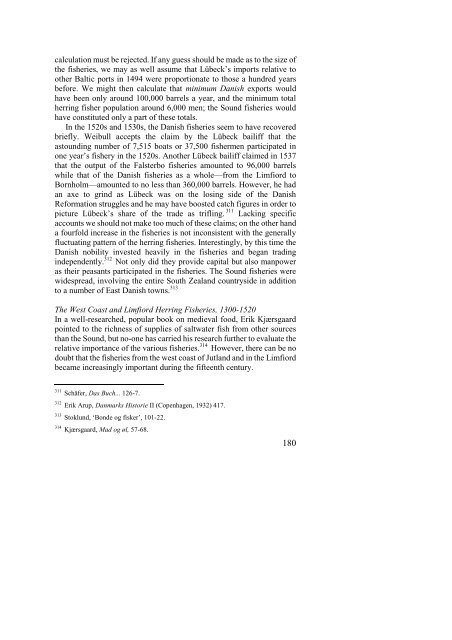The North Atlantic Fisheries, 1100-1976 - University of Hull
The North Atlantic Fisheries, 1100-1976 - University of Hull
The North Atlantic Fisheries, 1100-1976 - University of Hull
Create successful ePaper yourself
Turn your PDF publications into a flip-book with our unique Google optimized e-Paper software.
calculation must be rejected. If any guess should be made as to the size <strong>of</strong><br />
the fisheries, we may as well assume that Lübeck’s imports relative to<br />
other Baltic ports in 1494 were proportionate to those a hundred years<br />
before. We might then calculate that minimum Danish exports would<br />
have been only around 100,000 barrels a year, and the minimum total<br />
herring fisher population around 6,000 men; the Sound fisheries would<br />
have constituted only a part <strong>of</strong> these totals.<br />
In the 1520s and 1530s, the Danish fisheries seem to have recovered<br />
briefly. Weibull accepts the claim by the Lübeck bailiff that the<br />
astounding number <strong>of</strong> 7,515 boats or 37,500 fishermen participated in<br />
one year’s fishery in the 1520s. Another Lübeck bailiff claimed in 1537<br />
that the output <strong>of</strong> the Falsterbo fisheries amounted to 96,000 barrels<br />
while that <strong>of</strong> the Danish fisheries as a whole—from the Limfiord to<br />
Bornholm—amounted to no less than 360,000 barrels. However, he had<br />
an axe to grind as Lübeck was on the losing side <strong>of</strong> the Danish<br />
Reformation struggles and he may have boosted catch figures in order to<br />
picture Lübeck’s share <strong>of</strong> the trade as trifling. 311 Lacking specific<br />
accounts we should not make too much <strong>of</strong> these claims; on the other hand<br />
a fourfold increase in the fisheries is not inconsistent with the generally<br />
fluctuating pattern <strong>of</strong> the herring fisheries. Interestingly, by this time the<br />
Danish nobility invested heavily in the fisheries and began trading<br />
independently. 312 Not only did they provide capital but also manpower<br />
as their peasants participated in the fisheries. <strong>The</strong> Sound fisheries were<br />
widespread, involving the entire South Zealand countryside in addition<br />
to a number <strong>of</strong> East Danish towns. 313<br />
<strong>The</strong> West Coast and Limfiord Herring <strong>Fisheries</strong>, 1300-1520<br />
In a well-researched, popular book on medieval food, Erik Kjærsgaard<br />
pointed to the richness <strong>of</strong> supplies <strong>of</strong> saltwater fish from other sources<br />
than the Sound, but no-one has carried his research further to evaluate the<br />
relative importance <strong>of</strong> the various fisheries. 314 However, there can be no<br />
doubt that the fisheries from the west coast <strong>of</strong> Jutland and in the Limfiord<br />
became increasingly important during the fifteenth century.<br />
311 Schäfer, Das Buch... 126-7.<br />
312 Erik Arup, Danmarks Historie II (Copenhagen, 1932) 417.<br />
313 Stoklund, ‘Bonde og fisker’, 101-22.<br />
314 Kjærsgaard, Mad og øl, 57-68.<br />
180















